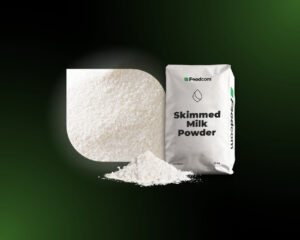- Milk powder and butter prices see declines due to increased product availability.
- Australia and New Zealand are preparing for the arrival of the bird flu virus, which could disrupt dairy production.
- The cheese market is reporting stability in cheddar prices, but declines in gouda, edam and mozzarella prices.
- Power cuts in Ukraine are increasing the cost of milk production and could lead to further price increases.
Welcome to Partners!
Welcome back to our newsletter!
The dairy market is showing price stabilisation in many segments, although some products, such as milk powder and butter, are seeing declines due to increased availability. Meanwhile, Australia and New Zealand are bracing themselves for the potential threat of avian influenza, which could affect dairy production and bring further price movements.
Let’s see what else has happened in the dairy market recently!
Milk powder
Skimmed milk powder (SMP) prices for feed have also seen a slight decline. Prices for the fourth quarter are around EUR 50 per tonne lower than last week on DAP Dutch/French terms.
Fresh produce, on the other hand, can be purchased at EUR 2450-2550/MT on FCA terms. The market shows a clear stabilisation, with no signs of price increases or decreases. From time to time, profitable opportunities can be identified in slightly older products offering a more competitive price point.
Whole milk powder (WMP) prices at GDT increased by 3.0%. This increase in WMP prices underlines strong demand and contributes to the overall positive trend in dairy markets. In Europe, prices are fairly stable.
Cheese
In the cheese market, Cheddar prices remained stable at EUR 5200/MT despite higher volatility, supported by seasonally low production in Ireland and the UK. On the other hand, Gouda and Mozzarella saw larger declines. Gouda cheese prices fell to €4800/MT and Edam to €4750/MT, driven by falling butter prices and cautious trade, while Mozzarella fell to €4600/MT, influenced by pressure on stocks and changes in cream prices. Many buyers have secured their needs for Q4, but uncertainty remains in the coming months. Lower milk production continues to drive volatility, although limited cheddar availability may support prices.
Fats
Butter prices saw a significant decline in the fourth quarter, falling to €7500-7700/MT, well below the market value of cream. The outlook for the first quarter of 2025 has also declined, with prices heading towards €7000/MT. In addition, futures prices have fallen even further. The fall in prices can be attributed to the influx of butter from other regions in Europe. As a result, prices for November and December are expected to fall slightly.
We could also see slight price decreases for products such as AMF (anhydrous milk fat) and butter oil.
Liquids
Prices are falling across Europe, with higher prices in some regions due to the greater availability of cream. In most dairies it is more profitable to produce cream than butter. Currently the price is €9750-9850/MT on FCA terms.
Skimmed milk concentrate prices have fallen even further. They currently range between EUR 2300/MT and EUR 2400/MT on FCA terms.
Milk prices across Europe remain stable, but will gradually start to fall. We anticipate that prices may adjust slightly in the coming weeks.
Whey powder
SWP (sweet whey powder) prices on DAP Netherlands delivery terms fell this week. They were previously at EUR 940/MT in the fourth quarter, but have now fallen to EUR 915/MT.
WPC 80% prices are fairly stable, after several weeks of large increases we are seeing price stabilisation.
What else?
Ukraine
Continuous power cuts are having a negative impact on the Ukrainian dairy industry. Denis Marchuk, vice-chairman of the All-Ukrainian Agricultural Council, warns that if the situation does not improve, meat, dairy and bread prices could rise significantly. Currently, damage to the Ukrainian energy system is affecting 60% of production capacity, leading to supply interruptions of up to 20 hours a day. The problem is particularly acute for dairy farmers, where production requires constant access to energy. Farms are forced to rely on more expensive backup power, which has already increased milk costs by 3-5%. The processing sector is also experiencing increased costs, with an additional 20-30% increase in the number of dairy product returns. Ventilation problems on farms have led to heat stress in cows, which negatively affects production. With a difficult winter ahead, the situation could get even worse.
Australia and New Zealand
Australia and New Zealand are making intensive preparations for the H5N1 avian influenza virus, which has already reached nearby regions such as Indonesia and Antarctica. Both countries are increasing biosecurity measures on farms, testing coastal birds and vaccinating endangered species. Oceania is the last region free of the devastating strain of the virus, which has killed millions of birds and mammals worldwide since 2020. Influenza can negatively affect not only the poultry industry, but also other agricultural sectors such as dairy, where power outages and deteriorating animal health are causing price increases. In addition, the virus causes heat stress in livestock, which reduces their productivity, especially among dairy cows. Preparatory exercises and simulations are being carried out in both countries to test preparedness for a possible epidemic. Experts warn that despite the geographical isolation, the risk of migrating birds introducing the virus into the region is increasing, especially during the spring months.
![Falling dairy prices – stabilisation or the start of major changes? [239th edition of DAIRY newsletter] Falling dairy prices – stabilisation or the start of major changes? [239th edition of DAIRY newsletter]](https://foodcom.pl/wp-content/uploads/2024/06/Foodcom_SA_Dairy_Newsletter_4-1520x760.jpg)






